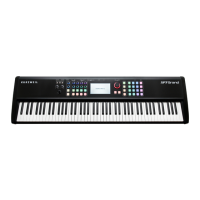39
5-1-1-3 Bit Crusher
The Bit Crusher section is a digital degradation distortion.
It intentionally introduces quantization noise and aliasing
artifacts, allowing you to adjust the Bit Resolution,
Down Sampling Factor, Output Brightness, and Output
Level.
Bit Resolution - Allows you to set the bit depth of the signal,
ranging from 24 bits down to 1 bit. Lower values increase
5-1-2 P.EQ (Parametric Equalizer)
The EQ section is a 4-band parametric. With each band
you can choose between 7 EQ types using the selector
tabs at the top of each band: a LPF 6dB, LPF 12dB,
LowShelf, Peak/Notch, HighShelf, HPF 6dB and
HPF12dB.
For each EQ type (excluding the LPF/HPF) you can set
the frequency (Freq), quality factor (Q), and gain (Gain).
Chapter 5
Chapter 5. FX Editing
LPF 6dB and LPF 12dB - Low pass filters that reduce high frequencies above the set frequency. 6dB and 12dB
slopes are available. The higher the slope, the steeper the cut off.
LowShelf - A low shelving filter that cuts or boosts frequencies below the set frequency.
Peak/Notch - A fully parametric filter with controls for specifying the center frequency (Freq), width of the
frequency band around the center frequency (Q) and amount of boost/cut (gain) for the specified area..
HighShelf - A high shelving filter that cuts or boosts frequencies above the set frequency.
HPF 6dB, HPF 12dB - High pass filters that reduce low frequencies below the set frequency. 6dB and 12dB
slopes are available. The higher the slope, the steeper the cut off.
5-1-3 Mod/Wah (Modulation, Wah)
The Mod/Wah section offers separate modulation and “wah-wah” effects. Only one of these effects can be used at
a time, so you must designate one or the other by way of the selector tab at the top center of the parameter area.
Modulation
The Modulation effect consists of 5 options: Rotary, Chorus, Vibrato, Flanger, and Phaser. These are chosen using
the selector tab to the right of the main Modulation/Wah selector.
Output Brightness - A low pass filter allowing you to process the post distortion signal.
Drive - Adjusts the input gain feeding into the distortion circuit. Increasing the drive will increase the given
distortion effect.
Output Level - Controls the overall level of the post-distortion effects section.
Drive - Adjusts the input gain feeding into the distortion circuit. Increasing the drive will increase the given
distortion effect Output Level - Controls the overall level of the post-distortion effects section.
the number of sampling errors, generating more distortion.
Down Sampling Factor - Reduces the sample rate, introducing aliasing. A value of 1 has no effect on the signal. Higher
values increase the artifacts.
Output Brightness - Is a low pass filter allowing you to color the post it-crushed signal.
Output Level - Controls the overall level of the post bit-crushed effects section.

